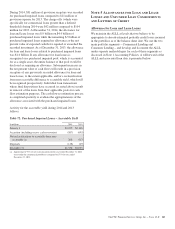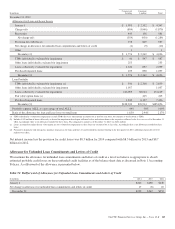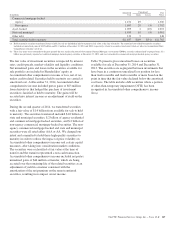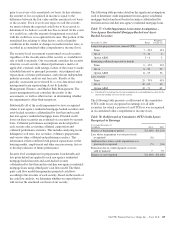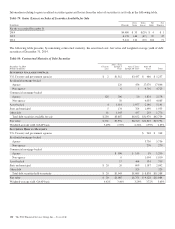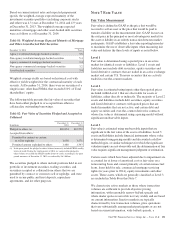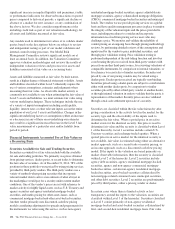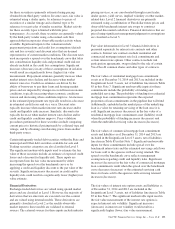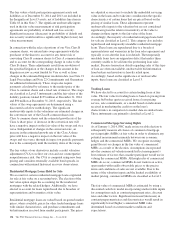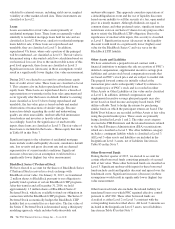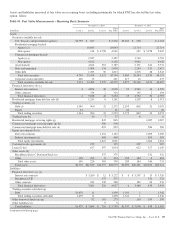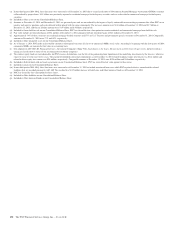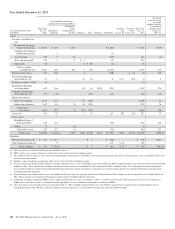PNC Bank 2014 Annual Report Download - page 171
Download and view the complete annual report
Please find page 171 of the 2014 PNC Bank annual report below. You can navigate through the pages in the report by either clicking on the pages listed below, or by using the keyword search tool below to find specific information within the annual report.for these securities is primarily estimated using pricing
obtained from third-party vendors. In some cases, fair value is
estimated using a dealer quote, by reference to prices of
securities of a similar vintage and collateral type or by
reference to recent sales of similar securities. Market activity
for these security types is limited with little price
transparency. As a result, these securities are generally valued
by the third-party vendor using a discounted cash flow
approach that incorporates observable market activity where
available. Significant inputs to the valuation include
prepayment projections and credit loss assumptions (default
rate and loss severity) and discount rates that are deemed
representative of current market conditions. The discount rates
used incorporate a spread over the benchmark curve that takes
into consideration liquidity risk and potential credit risk not
already included in the credit loss assumptions. Significant
increases (decreases) in any of those assumptions in isolation
would result in a significantly lower (higher) fair value
measurement. Prepayment estimates generally increase when
market interest rates decline and decrease when market
interest rates rise. Credit loss estimates are driven by the
ability of borrowers to pay their loans and housing market
prices and are impacted by changes in overall macroeconomic
conditions, typically increasing when economic conditions
worsen and decreasing when conditions improve. An increase
in the estimated prepayment rate typically results in a decrease
in estimated credit losses and vice versa. Discount rates
typically increase when market interest rates increase and/or
credit and liquidity risks increase. Similarly, discount rates
typically decrease when market interest rates decline and/or
credit and liquidity conditions improve. Price validation
procedures performed for these securities include comparing
current prices to historical pricing trends by collateral type and
vintage, and by obtaining corroborating prices from another
third-party source.
Certain infrequently traded debt securities within the State and
municipal and Other debt securities available-for-sale and
Trading securities categories are also classified in Level 3.
The significant unobservable inputs used to estimate the fair
value of these securities include an estimate of expected credit
losses and a discount for liquidity risk. These inputs are
incorporated into the fair value measurement by either
increasing the spread over the benchmark curve or by
applying a credit and liquidity discount to the par value of the
security. Significant increases (decreases) in credit and/or
liquidity risk could result in a significantly lower (higher) fair
value estimate.
Financial Derivatives
Exchange-traded derivatives are valued using quoted market
prices and are classified as Level 1. However, the majority of
derivatives that we enter into are executed over-the-counter
and are valued using internal models. These derivatives are
primarily classified as Level 2 as the readily observable
market inputs to these models are validated to external
sources. The external sources for these inputs include industry
pricing services, or are corroborated through recent trades,
dealer quotes, yield curves, implied volatility or other market-
related data. Level 2 financial derivatives are primarily
estimated using a combination of Eurodollar future prices and
observable benchmark interest rate swaps to construct
projected discounted cash flows. Financial derivatives that are
priced using significant management judgment or assumptions
are classified as Level 3.
Fair value information for Level 3 financial derivatives is
presented separately for interest rate contracts and other
contracts. Interest rate contracts include residential and
commercial mortgage interest rate lock commitments and
certain interest rate options. Other contracts include risk
participation agreements, swaps related to the sale of certain
Visa Class B common shares and other types of contracts.
The fair values of residential mortgage loan commitment
assets as of December 31, 2014 and 2013 are included in the
Insignificant Level 3 assets, net of liabilities line item in Table
85 in this Note 7. Significant unobservable inputs for these
commitments include the probability of funding and
embedded servicing. The probability of funding for residential
mortgage loan commitments represents the expected
proportion of loan commitments in the pipeline that will fund.
Additionally, embedded in the market price of the underlying
loan is a value for retaining servicing of the loan once it is
sold. Significant increases (decreases) in the fair value of a
residential mortgage loan commitment asset (liability) result
when the probability of funding increases (decreases) and
when the embedded servicing value increases (decreases).
The fair values of commercial mortgage loan commitment
assets and liabilities as of December 31, 2014 and 2013 are
included in the Insignificant Level 3 assets, net of liabilities
line item in Table 85 in this Note 7. Significant unobservable
inputs for these commitments include spread over the
benchmark interest rate and the estimated servicing cash flows
for loans sold to the agencies with servicing retained. The
spread over the benchmark curve reflects management
assumptions regarding credit and liquidity risks. Significant
increases (decreases) in the fair value of commercial mortgage
loan commitments result when the spread over the benchmark
curve decreases (increases) or the estimated servicing cash
flows for loans sold to the agencies with servicing retained
increases (decreases).
The fair values of interest rate option assets and liabilities as
of December 31, 2014 and 2013 are included in the
Insignificant Level 3 assets, net of liabilities line item in Table
85 in this Note 7. The significant unobservable input used in
the fair value measurement of the interest rate options is
expected interest rate volatility. Significant increases
(decreases) in interest rate volatility would result in a
significantly higher (lower) fair value measurement.
The PNC Financial Services Group, Inc. – Form 10-K 153


